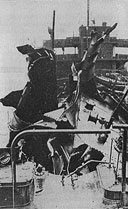
3. Buoyancy
Do not jump overboard unless you have no
alternative. That is what this explanation of
buoyancy -- the power to keep afloat -- is intended
to impress upon you.
For a vessel to stay afloat, the upward pressure
of the water must be equal to the downward
pressure or weight of the vessel. However,
because a ship is torpedoed, it does not necessarily
follow that the balance of opposing pressures
is going to be so altered that the ship must
sink. Four men on the torpedoed tanker Malay
were unable to consider this, and they lost their
lives, though the Malay itself made port safely.
A vessel is composed of several units. Each
hold, as well as the fireroom and engine room, is
an independent buoyant section.
Picture in your mind a small freight vessel.
Visualize each hold as being detached from the
other. Each, as you picture it, is now floating independently.
The engine room and fireroom, you
will see, are floating deep. The #1 and #4 holds
are not quite so deep. The #3 hold has less draft,
while the #2 hold has the least depth of all.
--29--
The sums of all these individual buoyancies
make the total buoyancy of the vessel.
Though the tanker E.H. Blum was broken in
two by a torpedo, the forward half still had sufficient
buoyancy to permit it to be towed to port.
Captain Theodore Bockhoff understood the
buoyancy set-up of his stricken freighter after
it was hit by a torpedo. That is why he ordered
Seaman James Sherlock, who was running for
the starboard boat, to wait. A few moments
later, as the starboard lifeboat reached the water
with six men in it, a second torpedo blew it to bits.
When the torpedoed tanker Gulftrade broke
in two, nine men were on the stern. Seaman
Leonard Smith wanted to jump overboard. Guy
F. Chadwick, the chief engineer, reminded Smith
that the water was cold. "Let's stick with the
ship," Chadwick advised, "as long as she'll stick
with us." At the very least, the chief's understanding
of buoyancy spared a man from exposure
and frostbite.
Suppose the vessel is loaded with lumber, and
a hold is stove in. Since the specific gravity of
wood runs from one-fifth to a slight fraction
beyond that of water, the only loss is in the reserve
buoyancy, as the lumber's buoyant qualities
will substitute for the loss of actual
--30--
buoyancy. The space which the sea can occupy is
only the area not already taken up the lumber.
Often, when only one or two buoyant sections
are immediately damaged, the vessel eventually
sinks. The China Arrow, torpedoed twice, took
an hour sink. This was probably due to the
fact that while the destruction of tanks in the
vicinity of the blasts was not enough to sink
the China Arrow, the detonations sheared plates
and loosened rivets in the tanks beyond. Buoyancy
is often lost on tankers when heat from the
oil blaze buckles the plates. Our point is that
it takes time for this buoyancy to be lost.
This is borne out by the Latvian freighter
Ciltvaira. After abandoning ship the men were
able to go back, run up SOS flags, and salvage
valuables. Captain T.R. Hennevig returned to
his crippled freighter eight hours after it had
been torpedoed and shelled. A sugar transport
vessel, torpedoed off Nuevitas, Cuba, remained
afloat and was beached, though 22 crewmen died
when lifeboats were sunk by gunfire.
A hold stowed with general cargo presents a
serious condition. All the buoyancy of that hold
would be lost. Grain cargo likewise adds a threat
to a stricken vessel. Expanding from absorbed
water, the grain will exert pressure on the watertight
bulkhead and loosen rivets.
--31--
In short, experience and the laws of physics
indicate that men usually have more time to
abandon ship than they allow themselves. However,
statistics are often contradicted by an individual
situation, so don't let them lull into
carelessness. Ships have sunk in five minutes or less.
For your protection discuss with the mates
and engineers the buoyancy problems of your
ship. And before you jump, remember that
Bryan Lloyd, a seaman, had time to swim back
to his ship from a swamped lifeboat, rest five
minutes, and release a liferaft. Captain Knut O.
Bringedal was able to return to his torpedoed
vessel three times. And the tanker Esso Bolivar,
with water ballast, was towed into port with a
40-foot hold blasted in her side.
--32--

This old-type tanker made port under her own power.
(Official U.S. Navy photograph--International News Photos)
--33--
Table of Contents
Previous Chapter (2) *
Next Chapter (4)

